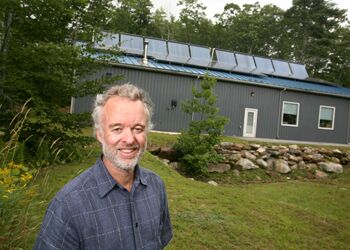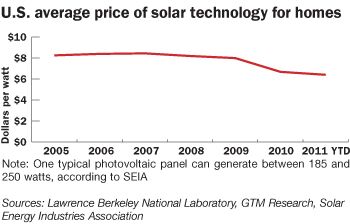Processing Your Payment
Please do not leave this page until complete. This can take a few moments.
Switching to solar | A select few embrace a long-term investment
When Charles Duvall, owner of Duvall Design in Rockland, expanded his business four years ago by building a 5,000-square-foot, high-ceiling studio, he installed a radiant floor with embedded piping covered by a 6-inch slab. Initially, he used oil to heat the floor, but it occurred to him he should instead take advantage of the sun. "A lot of my building is hot from the sun anyway," he says.
After investing $40,500 in a solar thermal heating system — nearly half of which was paid for with federal and state incentives — Duvall now saves roughly $9,500 a year on oil costs. "It's a long-term investment," Duvall says. "I'm happy to do it because it feels like the right thing to do. How can we not do this? It's insane to pay for oil. Still, it is a big capital investment for a small business." Duvall founded his business in 1994 and, with a staff of between six and 12, designs high-end, artistic fabric structures for museums, trade shows and other commercial venues.
Duvall is one of many people in Maine worried about high heating bills and wondering whether solar energy can be a solution. "We have a lot of people call us asking, 'Can I heat with solar?'," says Jennifer Hatch of ReVision Energy, a Portland-based solar installation company. She usually replies with the glum news that, "for most people it makes no sense. The best thing they can do is make their home more efficient."
Solar heat is impractical for Mainers who live or work in leaky old buildings with thin walls and roofs that don't slope southwards, but there are some for whom the sun, that great fiery ball of reliable warmth, works well.
"It is a rare circumstance, but it can happen," says John Luft, general manager of ReVision Energy's Liberty branch. He says his company installs solar heating systems for, at tops, 5% of its clients. "We need a very new, modern building of modest size and well insulated. That's why it's only one to five percent of the market right now." The company mostly installs solar panels for electricity and hot water systems.
Those who have new, well-insulated, south-facing, smallish buildings, and who would like to avoid using fossil fuels for heat, have generally three solar options: solar thermal with radiant floors, air-source heat pumps and resistive electric systems. Thermal units take advantage of solar hot water systems, which are commonly associated with the hot water that comes out of the kitchen faucet. When used for space heating, solar thermal systems circulate water, heated to 90 to 120 degrees, through tubing installed underneath floor slabs. Air-source heat pumps work somewhat like a reverse refrigerator by extracting heat from outdoor air and pushing it into a room, and can also reverse direction to become air conditioners. Examples of resistive electric systems are your old-fashioned baseboard heaters or mini room-heaters. Air-source heat pumps and resistive electric heaters can use power generated by rooftop solar electric panels, while thermal systems often use a different rooftop system of evacuated tube-like collectors rather than flat panels. According to ReVision, heat pumps are two and a half times more efficient compared to resistive electric heaters.
Prices for installing solar heating systems can vary widely and be expensive, depending on the scope of the project. Kate Rush, a partner at Evolo Energy Solutions, a solar company in Newport, says a system can range from $15,000 to several hundred thousand dollars. Fred Greenhalgh, ReVision Energy's online marketing manager, says an average solar system might cost $30,000, or twice as much as a new oil heating system. But Rush points out that all new residential and commercial solar heat systems benefit from a 30% federal tax break, as well as Maine's low-interest borrowing program for alternative-energy systems called PACE, and whatever state rebates for solar energy are available at the time.
Which system to choose?
While converting a radiant floor that already runs on oil to solar-heated water could make sense, industry experts say new buildings are better off not using thermal systems for heat because they are costly to install and overproduce during the sunny summer months and underperform during the short, gray days of winter. Instead, Luft recommends using electric heating units, because the electricity a solar building generates but doesn't use in the summer runs back into the grid for credit that can be applied to a winter heating bill.
"If you make a kilowatt hour and don't use it, you can store it and can get a credit," Luft says. "There's never any waste with a system like this."
In 2009, Luft helped The Jojoba Co., which sells organic jojoba products in Waldoboro, install a radiant floor in a new, super-insulated post-and-beam structure. To heat it, the company's owners, Bob and Sally Butler, set up an electric boiler powered by photovoltaic panels to heat water that runs through their radiant floor.
Their building, which has slightly more than 3,000 square feet, has 60 photovoltaic panels on its roof that this year will put out 18,000 kilowatt hours, according to Bob Butler. The system cost about $50,000, Butler recalls, after using his federal tax credit and state rebate.
He says his and his wife's decision to convert to solar was "value-driven, not strictly market driven." He explains, "Solar power is the cleanest power available, it's quiet, and even though the payback period is longer than that of conventional systems, we decided early on that we were less interested in the cash-flow economics of the system and more interested in its environmental impact."
Besides resistive electric systems, such as the Butlers' electric boiler, Luft says heat pumps can also be a good investment for well-insulated buildings, especially as their technical performance in colder climates improves.
In Portland, Paul Ledman and his wife, Colleen Myers, recently constructed a three-unit apartment building on an empty lot on Commercial Street. They're heating their 4,400-square-foot building with four air-source heat pumps mounted on the outside wall. Ledman says he invested two-thirds of what he would have spent on a fossil-fuel heating system on his solar heating system, and that it will pay for itself in five years from savings on oil bills. As a back-up, during stretches of rainy, overcast days, he'll use grid electricity, he says.
Ledman built the house to conserve energy, investing the extra he saved on the heating system in additional insulation. "The key is if you don't waste energy in the first place, you don't need fuel," he says. On his roof, he's installed 30 panels for electricity and 90 tubes for hot water.
Ledman and his wife decided to build a solar-efficient home to escape the "up-and-down oil manipulations" of companies like Exxon, as Ledman puts it. "Energy prices will continue to skyrocket and it won't mean anything to us," he says. "Plus it's what people should be doing."
Rebecca Goldfine, Mainebiz staff writer, can be reached at rgoldfine@mainebiz.biz.
Switching to wood pellets | Maine-made appeal rekindles nascent industry
Switching to natural gas | Investment rolls in amid clean water worries
Read more
Switching to wood pellets | Maine-made appeal rekindles nascent industry
Switching to natural gas | Investment rolls in amid clean-water worries
Price volatility and environmental concerns fuel interest in three energy industries
Switching to wood pellets | Maine-made appeal rekindles nascent industry
Switching to natural gas | Investment rolls in amid clean-water worries
Price volatility and environmental concerns fuel interest in three energy industries












Comments